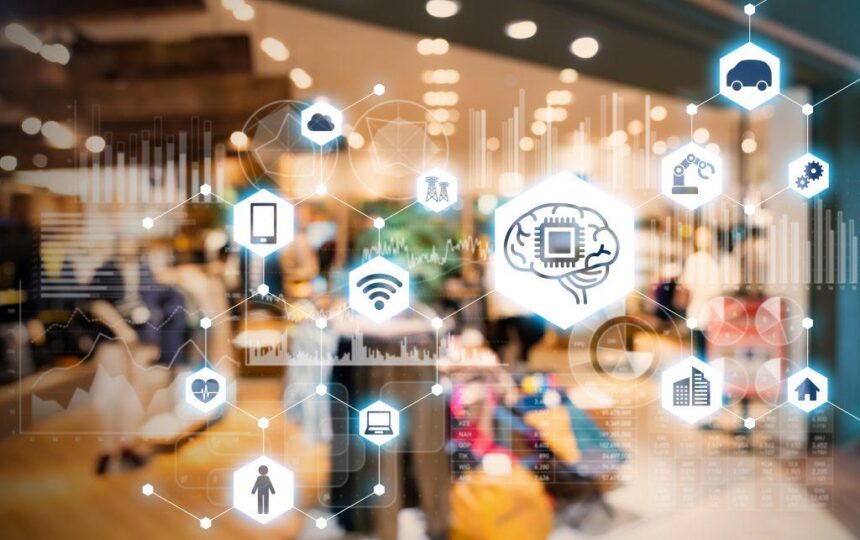In-store retail technology can elevate your store and make it into something more for the customer. Tech has become a critical element of store functionality and design, being incorporated into interactive digital signage software, contactless payment methods, and more. A retail store may use a mix of technology, but no company necessarily needs to have everything on this list.
As a starting point and something to think about, here are some good technologies for retail stores.
Smart Chatbots
An AI-driven chatbot utilized in-store through digital signage can help customers find what they’re looking for in seconds—without waiting for an answer or fussing. A smart chatbot is a game-changer and frees up retail customer service.
Smart Shelves
Smart shelves streamline inventory management. They use sensors and RFID tags to automatically track product levels in real time, providing an inventory manager with accurate and up-to-date information.
App Integration
More retailers allow customers to download an app, reserve or buy products on their phones, and arrange in-store pickup. For customers who enjoy buying products online, app integration allows a retailer to sell more.
Customer Loyalty Points App
Take your customer loyalty program digital with in-app rewards and offers. This will encourage repeat business and provide a direct way to interact with customers.
Digital Signage
As mentioned earlier, digital signage software is dynamic and customizable. It is the best way to advertise time-sensitive promotions, make announcements, and provide real-time updates in-store. Customize your display based on traffic, seasonal events, and ongoing specials!
Point-of-Sale Systems
Point-of-sale systems streamline transactions, help track inventory and create and monitor customer data. Modern POS systems form a key element of the retail shopping experience.
Self-Checkout Kiosks
With high-traffic stores likely to experience cashier bottlenecks, try self-checkout kiosks. These kiosks allow customers to scan and pay for items without human intervention, reducing wait times and improving the customer experience.
Contactless & Mobile Payments
Contactless payments are a must in retail checkout. They complete transactions quickly and securely, minimizing the need for physical contact.
Mobile payment systems support platforms like Apple Pay and Google Wallet, making it easier for customers to pay for items using their smartphones without taking out a physical wallet.
Customer Behaviour Analysis
Track customers as they make their way through the store. AI customer behaviour analysis helps to understand customer preferences, enabling a retailer to optimize its product displays and store layout to feature best-sellers and products most likely to make them profitable.
Augmented Reality
Augmented reality blends the digital with the physical. Customers use their smartphones to view store products in interactive, immersive ways, such as visualizing a retailer’s furniture in their home or trying on clothes virtually. AR offers an unparalleled personalized retail shopping experience.
Beacons in Retail
Beacons are Bluetooth low-energy, or BLE, technology that sends location-based notifications to customers’ smartphones. When they are close to your store, beacons can send promotions, reminders, or personalized offers to entice customers to enter.
Interactive Product Displays
Combine digital signage with product displays to create unique and engaging exhibits. Digital signage allows you to include all the specs, demos, and how-to guides and show a product in action.
Retail Security Technologies
Several in-store retail security innovations in recent years have made it easier to identify theft. Advanced surveillance with high-definition video cameras and real-time AI monitoring.
Centralized security systems with integrated alarms, access controls, and robust crime deterrents. RFID tags on merchandise to track location in the store.
Voice-Activated Shopping Assistant
Imagine shopping in a retail store with a voice assistant on your smartphone guiding you. A retail store can set this up through its app, maximizing the in-store experience and helping busy customers get the needed products.
Inventory Management Software
Inventory management software tracks stock in real-time, reducing overstocking or stockouts. This software can often be automated to optimize the reordering process and track product demand.
Customer Relationship Management Software
CRM software collects and analyzes customer data, which can be used for personalized marketing and customer retention. It allows you to learn individual preferences and shopping habits, tailoring promotions and communications to specific customers.
Facial Recognition
Brands like Walmart are experimenting with facial recognition software. They’ve applied it to detect and reduce retail crime, and it’s also been used to identify shoppers who are unhappy or frustrated so that customer service can be dispatched to them.
Heat Mapping
Heat maps can help you better understand your store’s popular zones. These monitor user activity, typically through IoT devices. A heat map of your store layout can also help you know where to put products on sale best and how to optimize your store layout for maximum sales.






